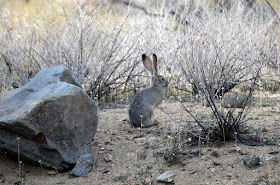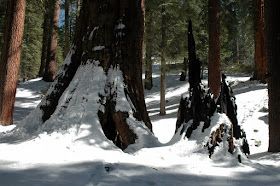We were here last year during our stay at the Army's Yuma Proving Ground RV Park (Desert Breeze). We both like the dates and eat them like candy. Too many however can get you making more trips to the potty than normal, so I try to hold my intake to less than 6 or 7. But the date shakes are really good. Yummy! I try to hold my intake to less than 7 also for these. Ha!
This was our little tour wagon and the guide was actually the 42 year old son of the the owner/founder of the orchard. Martha is actually his grand mother. We never realized how much effort went into the pollenization, cultivation, and harvest of these dates, in this desert setting. Each female tree (8000) must be hand-pollenated from the flower of the 80 male trees. The guide went into excrutiating details of the entire operation of the family run and operated farm/ranch.
Above, he is attempting to show us the female pod that is about to "bloom", at which time it will be ready to receive the male pollen. Below is the female pods. The bag he is holding will be placed around the entire pod after pollenating. The bag protects the pod from birds, insects and rodents. It also protects the dates when near-ripe from the sand/dust as they become very sticky.
They also have rattlesnakes to contend with, but they keep the rodents (ground squirrels) in check somewhat. But the rodents are their biggest challenge. They use a decon-like killer to help in controlling their numbers as well.
Above & below are pics of the Gila River flood plain and the fertile valley of many centuries of floods. The river long ago was dammed and diverted with the Colorado River in order to establish a series of canals and irrigation capabilities for the huge produce growing, citrus, and many other hay/cotton crops that are grown throughout the year.
The canal above is one of the many throughout the Yuma Valley. The sol is so rich, it appears that anything could be grown here, and it does, according to our guide.
Abovem he explains that the tree produces many leaves/branches that sell to the local artisans/crafts people to make all sorts of baskets, hats and other items for sale in the local tourist traps.
Above is an example of how each mature tree produces many offshoots that wind up being cut, transplanted, and eventually put in the ground and makes another tree. Each tree will produce 4-6 offshoots each year.
Above, he explains the harvest/sorting/grading/freezing/packing/shipping processes. We just couldn't get over the amount of labor that goes into the entire cycle of how the dates get to the consumer.
Above is the device that is used to "lift" the workers up to pollenate/bag/harvest the dates.
Above are some of the offshoots that were recently transplanted into pots in one of the nurseries. Below is a tree (female) that has just been pollenated. In a few days each pod will be wrapped in a bag.
We did wind up buying a large box of the Medjool dates. We froze most of them and will enjoy them for many weeks to come. Well, so ends our tour of Martha's Garden. It was 90 minutes of education and quite relaxing to ride around in the warm sunny afternoon. So, until next time, RVing Beach Bums, Joe & Nancy.










































































